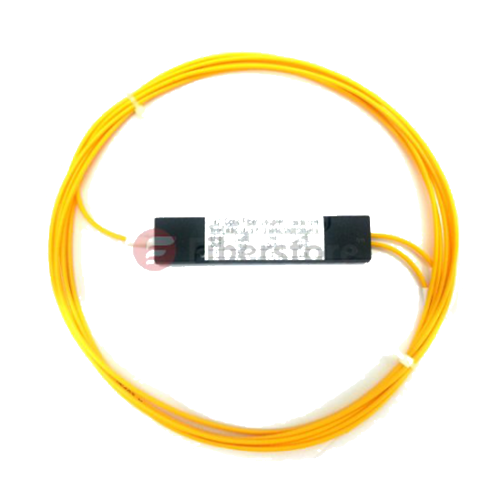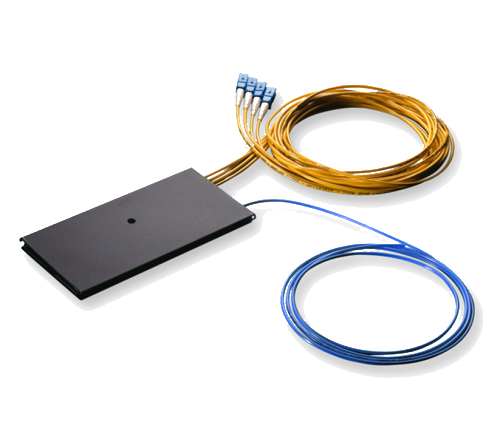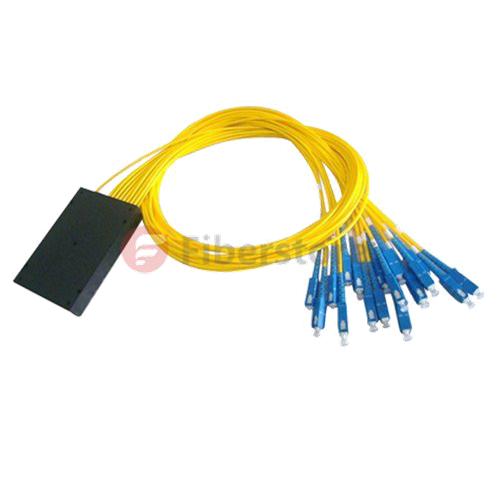FBT splitter, or FBT coupler, is an optical splitter that uses the Fused Biconic Taper (FBT) technique. The FBT technique is a well known industry technology for splitting optical power and/or splitting wavelengths. The fused fiber coupler is created through a process of fusing two bare fibers like an “X” and pulling the fused section to achieve the desired optical characteristics. FBT couplers are fused in tree structures to combine optical splitting effects to create power ratio output of 1×N or 2×N, where “N” is the number of desired outputs.
1×2 FBT couplers are used to split light with minimal loss from one into two fibers or to merge light from two fibers into one. 1×N tree FBT couplers and N×N star FBT couplers are made with fuse cascade-connecting N-1 pieces of 1×2 and 2×2 couplers respectively. There are mainly three types of FBT coupler splitters.
1. Standard Type
Standard FBT couplers have minimal excess loss and long-term stability. Unused ports are terminated to reduce back reflection. There are also polarization-independent FBT couplers based on the standard type. However, they have extra-low Polarization Dependent Loss (PDL) of less than 0.04 dB for coupling ratio 50/50, suited for applications where PDL of the system is critical. Here is an example of standard type 1×2 fiber splitter that uses FBT technique.

2. Wideband Type
The wideband FBT couplers have wide bandwidth, minimal excess loss, long-term stability and high directivity. They are optimized at 1310 nm, 1550 nm, or WDM wavelengths, and is available in a variety of coupling ratios. Covering 1260 nm to 1620nm, the bi-directional wideband couplers are suitable for WDM applications. These couplers are cost-efficient building blocks in WDM optical networks that allow splitting multiple signals transported over CWDM with one module into two redundant paths. There are also polarization and wavelength independent FBT couplers based on the standard wideband type. With very low PDL of less than 0.05 dB for coupling ratio 50/50, they are suited for applications where PDL of the system is critical. Here is an example of wideband type 1×8 fiber splitter that uses FBT technique.

3. Dual-window Type
The dual-window FBT couplers have dual windows of 1310 nm and 1550 nm, minimal excess loss, long-term stability and high directivity. They are optimized at 1310 nm and 1550 nm, and is available in a variety of coupling ratios. There are also polarization-independent dual-window FBT couplers base on the standard dual-window type. With very low PDL of less than 0.06 dB for coupling ratio 50/50, they are suited for applications where PDL of the system is critical. Here is an example of dual-window type 1×16 fiber splitter that uses FBT technique.

As one of the key components for GPON FTTx networks, FBT coupler splitters can be placed in the Central Office or in one of the distribution points (outdoor or indoor) because they are highly stable for multiport optical signal splitting with low insertion loss. FBT coupler splitters are designed for power splitting, telecommunication equipment tapping, and are excellent for duplex transmission on a single fiber in CATV systems or within fiber optic test sets. FBT tree couplers are also created for WDM systems to achieve different levels of wave isolation from the various outputs.